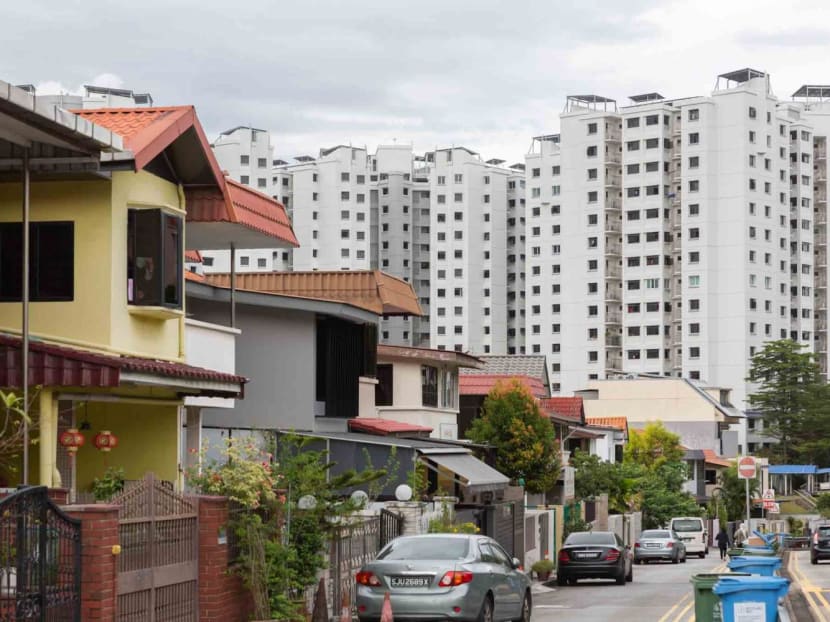Explainer: After strong HDB resale and private home price gains for most of 2022, why did the pace slow in Q4?
SINGAPORE — The latest data showing that the pace of price rises for both public and private housing slowed in the final quarter of 2022 can be attributed to rising inflation, higher borrowing costs and the impact of government cooling measures introduced in September, experts said.

- Private home prices in Singapore rose at a marginal pace of 0.2 per cent in the fourth quarter of 2022 from the previous quarter
- This was from flash estimates released by the Urban Redevelopment Authority
- For Housing and Development Board flats, resale price growth slowed further to 2.1 per cent in the fourth quarter
- Experts said that along with the success of cooling measures, higher borrowing costs are among significant factors, with expectations of economic slowdown in the backdrop
SINGAPORE — The latest data showing that the pace of price rises for both public and private housing slowed in the final quarter of 2022 can be attributed to rising inflation, higher borrowing costs and the impact of government cooling measures introduced in September, experts said.
Still, they noted that it was hardly a dramatic turnaround. Prices for both private property and Housing and Development Board (HDB) units still went up in the October-December period, just not as rapidly as before.
For HDB flats, resale price growth slowed to 2.1 per cent last quarter after prices rose 2.6 per cent in the third quarter, the board's flash estimates released on Tuesday (Jan 3) showed.
Although last quarter's price growth was the smallest quarterly increment since the third quarter of 2020, when prices grew by 1.5 per cent, prices have nonetheless risen for 11 consecutive quarters.
Resale HDB prices rose a sizzling 10.3 per cent in 2022, but still slower than the 12.7 per cent increase in 2021.
In private property, the slowdown as the year wound down was more pronounced.
According to flash estimates released by the Urban Redevelopment Authority (URA) on Tuesday, private home prices rose 0.2 per cent in the fourth quarter from the previous quarter, markedly down from a 3.8 per cent jump in the third quarter.
For the whole of 2022, prices of private homes rose a solid 8.4 per cent, lower than the 10.6 per cent in 2021 but far higher that the 2.2 per cent in 2020.
Prices of non-landed private residential properties in the so-called "outside central region", which includes areas such as Bedok and Punggol, decreased by 2.6 per cent in the fourth quarter 2022, compared to a 7.5 per cent increase in the previous quarter.
Regions such as the "rest of central region" and "core central region" notched up price increases in the final quarter but they were smaller than those recorded in the third quarter.
TODAY takes a look at the possible factors behind why the markets turned lukewarm towards the end of 2022.
DID THE COOLING MEASURES AND HIGHER INTEREST RATES WORK?
Property market analysts told TODAY that the property cooling measures announced by the Government on Sept 30 succeeded in putting a damper on price growth for both condominiums and HDB units, aided by rising interest rates.
A key feature of the cooling measures was private-home sellers wishing to buy a resale HDB flat would have to wait 15 months before being permitted to do so, with some exceptions.
Ms Christine Sun, senior vice-president of research and analytics at property firm OrangeTee, said that interest rate hikes affected buyers who are not eligible for an HDB loan.
“The fixed home loan rates offered by many banks are around 4 per cent, while some floating loan rates have already exceeded 3.5 per cent,” she said.
Agreeing on the point of higher interest rates, Mr Lee Sze Teck, senior director of research at Huttons Asia, also said that slower increase in prices reflects the willingness of HDB owners to be more open to negotiations after the cooling measures.
Ms Sun also said that that softening of prices is in line with a weaker macroeconomic projection against a backdrop of rising mortgage rates and spiralling inflation.
“The higher borrowing costs lowered buyers’ housing affordability. Further, (the) cooling measures introduced in September have lowered the borrowing limits of many buyers,” she said.
Agreeing, Mr Wong Xian Yang, head of research at real estate services firm Cushman and Wakefield, said that a combination of the cooling measures, rising interest rates and an expected economic slowdown in 2023 have reined in buyer demand.
“Some developers could have also delayed new launches in the fourth quarter of 2022 as they assess buyer demand post new cooling measures, resulting in the demand being roughly halved compared to the preceding quarter-year,” he said.
FLATS: DOES SIZE MATTER?
Analysts also attributed the slowdown in price growth for HDB resale flats to the sale of fewer large flats, which typically fetch higher prices, during the last quarter.
Ms Sun said that the proportion of five-room flats, executive flats and multi-generation units sold dipped from 33 per cent (2,392 units) in the third quarter of 2022 to 30.1 per cent (1,876 units) in the fourth quarter.
The proportion of flats sold in mature estates, which tend to fetch higher prices than those in non-mature estates, also dipped from 41.7 per cent in the third quarter (3,024 units) to 39.8 per cent in the fourth quarter (2,479 units).
Dr Lee Nai Jia, head of real estate intelligence for data and software solutions with property website PropertyGuru, describes the buying preference for larger HDB flats as an enduring one, with work-from-home and hybrid working arrangements still the norm.
These arrangements tend to drive a wish for homeowners to have bigger places.
He added that some buyers are going as far to take a pre-emptive approach and buying up these bigger units as they fear such flat types may be out of their price range in the future, thereby pushing up prices and hence affecting transaction volumes.
“The size and dwindling supply of such flat types mean these bigger flats command price premiums,” he said.
As for million-dollar HDB flats, analysts said that the number of transactions appeared to have moderated in the final quarter after the Sept 30 cooling measures.
“Based on data up to Dec 29, 2022, an estimated 92 such flats were sold in the fourth quarter of 2022. This is 17.1 per cent lower than the previous quarter,” Dr Lee added.
In 2022, the number of million-dollar flats is estimated to be 369 or 1.3 per cent of the estimated total transaction volume of 27,773 HDB resale transactions.
Ms Wong Siew Ying, head of research and content at Propnex Realty, said that the 15-month wait-out period rule as a moderating factor behind this.
For private homes, the sale of new homes, excluding executive condominiums, slumped 69.1 per cent to 666 units, from 2,157 units in the third quarter, according to URA Realis data. This is in comparison to resale homes which fell 34.6 per cent from 3,710 in the third quarter to 2,360 in the fourth quarter.
Mr Wong from Cushman and Wakefield as well as property analyst Ying Khuan Pow from property website 99.co both attribute this to a "dearth of new launches" in recent months.
“New launches are not as affected by higher borrowing costs as they are on progressive payment scheme,” Mr Wong added.
WAS IT THE TIMING, TOO?
Ms Sun also attributed a seasonal factor to the slowing down in prices.
During the year-end, many Singaporeans rushed to travel overseas, resulting in developers holding back launches during the final quarter.
Agreeing, Altitude Real Estate's key executive officer Nelson Lim said that the fourth quarter of 2022 was the first year-end period in three years where borders restrictions were lifted, allowing for year-end holiday travels in high volumes.
Ms Tricia Song, real estate group CBRE's head of research for Southeast Asia, also said that with most major new launches already concluded in the year, the December holiday seasonal lull and September 2022’s fresh residential property curbs, both homebuyers and developers largely adopted a wait-and-see approach in the previous quarter.
"Buyers would have wanted to digest and ascertain the impact of the new measures."











